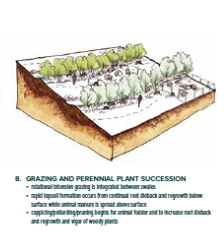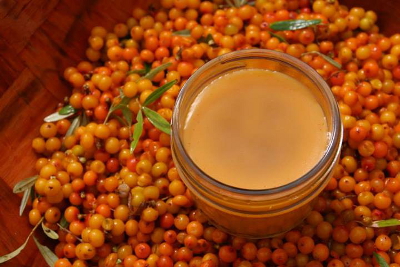
Medium-scale silvopasture systems
 The
facet of Falk's farm that I was most interested in was his forest
pastures. He started his permaculture adventures with Edible Forest Gardens
and followed many of the authors' guidelines at first, but soon
discovered that on the multi-acre scale, he had to tweak the design a
bit. The first thing to go was complicated guilds, which were too
much trouble to keep up by hand, but Falk found that grazing animals
made a good replacement for herbs under the trees.
The
facet of Falk's farm that I was most interested in was his forest
pastures. He started his permaculture adventures with Edible Forest Gardens
and followed many of the authors' guidelines at first, but soon
discovered that on the multi-acre scale, he had to tweak the design a
bit. The first thing to go was complicated guilds, which were too
much trouble to keep up by hand, but Falk found that grazing animals
made a good replacement for herbs under the trees.
Next, Falk discovered
that rows are under-rated. Many in the permaculture community like
to scatter plants around willy-nilly, but on a large scale, rows save
time and money since you can fence animals out of a planting easily and
can get equipment between rows. Most of Falk's rows are on-contour
hedges of black locust and seaberry, both of which are planted close
together (half a foot to a foot apart for the locusts and four to eight
feet apart for the seaberries), then pollarded
to form hedges (and to produce firewood). Falk warns that it's
essential to commit to mulching trees heavily for the first three to
four years and to fencing out deer for the first two or three
years. After that, the more-established trees are resilient and
can handle a certain amount of neglect.
 Although
I was intrigued by Falk's silvopasture system, I was disappointed to
see only diagrams, rather than photos, in his book --- that's always a
warning sign that an idea is still in its infancy. In addition,
Falk takes the permaculture party line about invasives, which I tend to disagree with, so he doesn't mention that seaberries are related to autumn olives and goumis and are potentially quite invasive, at least in Canada.
Although
I was intrigued by Falk's silvopasture system, I was disappointed to
see only diagrams, rather than photos, in his book --- that's always a
warning sign that an idea is still in its infancy. In addition,
Falk takes the permaculture party line about invasives, which I tend to disagree with, so he doesn't mention that seaberries are related to autumn olives and goumis and are potentially quite invasive, at least in Canada.
Those caveats aside, Falk's book definitely got me thinking about things I'd like to try, like tree alleys in our new pasture. If you want to read about his other systems --- like his rice paddies --- you'll have to check out The Resilient Farm and Homestead for yourself.
| This post is part of our The Resilient Farm and Homestead lunchtime series.
Read all of the entries: |
Want more in-depth information? Browse through our books.
Or explore more posts by date or by subject.
About us: Anna Hess and Mark Hamilton spent over a decade living self-sufficiently in the mountains of Virginia before moving north to start over from scratch in the foothills of Ohio. They've experimented with permaculture, no-till gardening, trailersteading, home-based microbusinesses and much more, writing about their adventures in both blogs and books.
Want to be notified when new comments are posted on this page? Click on the RSS button after you add a comment to subscribe to the comment feed, or simply check the box beside "email replies to me" while writing your comment.

Speaking of autumn olives, one of our local conservation areas here in Missouri is becoming quickly taken over by them. I believe the conservation department actually planted them because, on paper, they seem very beneficial to damaged land. I don't know if they just didn't do their research or if they planted it before they knew how it would behave in northwest Missouri, but it has taken over all the same. I would suggest that people avoid planting it. My question is this: If that were your land, how would you approach the problem? Do you think it'd be best to cut them down entirely and replant the area? Or do you think they could be managed with excessive harvest? I would think that harvesting the berries could only do so much. Even if a small portion were left, that's enough to grow dozens or even hundreds of new plants all spread by birds. Do you think I should contact the conservation department and let them know how out of hand they seem? I'm not sure how often a ranger checks the area, and even then I'm worried that they don't realize how rapid the spread has been. Thanks!
Thank you very much for your input! I've been asking multiple sources because that conservation area is so close by. I worry they might spread to my acreage, which has a lot of prairie land at the moment, making it easy to be over-taken by invasives. It has really changed in the past year. I only just now thought to notify someone because of how fast it spread. When I first spotted them last year, I guess I thought that the conservation department surely knew and had planted it with a plan in mind because I noticed new black locusts nearby as well. This doesn't appear to be the case, however. I don't think they would have let it get so unruly if they had planted it. I haven't had the time to call them during their regular office hours, but once I do call them, I will surely let them know. Thanks again! Your opinion means a lot.